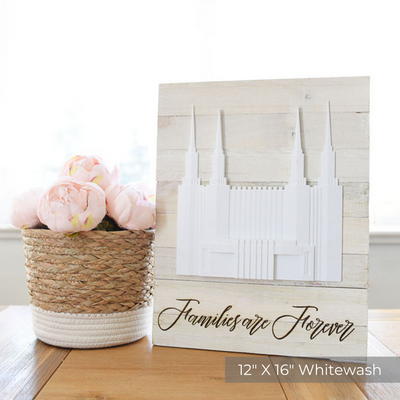Fine-Tuning Your Family's Temple Focus
By Kerry Smith
Picture a desert wilderness setting a very long time ago: the ancient tabernacle of Moses. What might you see? First, you might notice groups of people on all four sides, surrounding the exterior wall of white linen, carefully washed and maintained by loyal women. Individuals. Families. Groups of children. Every time they leave their tents, they see the tabernacle and symbolic purity surrounding it. In a hot, brown landscape, the visual and physical sacredness becomes the very focus of their lives.
In contrast, fast forward to our time. We often live in communities where individual homes have garages with doors that open and click with a button. We drive in and simply shut the door. Even if we don’t have garage doors, there’s still often little to no outer focus or interaction.
Some of us are blessed to live near a modern-day temple. We may even be able to spot it from our homes. Most of us are not so fortunate. Yet even for those who live within view of the Lord’s House, is it a primary focus? Is it what drives goals and desires?
Physical proximity is only one challenge. Many of us have children who are too young to attend the temple, or we have family members who don’t have temple recommends. Perhaps some loved ones don’t share a spiritual proximity to the temple either.
The good news is we can still include everyone who desires to join us, beginning at any time to help our families focus on the blessings of the temple and the promises of being together as a family for eternity. The key is to focus on common beliefs and the fact that God loves us all.

Focus on Tabernacle and Temple History
Talking about the history of something lends importance to it. There’s a feeling of connection to other people long ago, a feeling of greater significance and an overall whole.
Regarding temples, there are several history lesson options you could consider. It might be best to start simple as children often respond best to short, interesting ideas. You might begin, for instance, with a simple description of the tent-like tabernacle used when Moses and the Children of Israel were journeying in the wilderness and needed a portable worship space.
I was recently a tour guide for a traveling tabernacle exhibit. My responsibility was to talk about the outer layers covering the tabernacle. I was pleased to do so as this is something we rarely discuss, yet it holds great significance.
To protect against weather and harsh elements, the ancient tabernacle was covered with many animal skins bound together. The scriptures tell us badger hides were often used, as were other mammals from seacoast areas. Why? Such skins naturally protected against rain and other weather. Moisture simply rolled off the fur instead of soaking in.
Next was a layer of rams’ skins, dyed red to represent the sacrifices at the tabernacle.
Beneath the red was a layer of goat skins for warmth and protection. Insulation would be important for any building, and this layer was a smart choice.
Finally, the only layer seen from the inside was ornate. It was woven linen with blue, purple, red, and white colors. Cherubim decorations with gold were ornately woven into the layer as well.
All of these layers typify Christ and represent an aspect of His mortal ministry and divine calling as our Savior: Protection. Atonement. Warmth and comfort. Divinity.
You can certainly expand the lesson, talking more about each layer, but these are the basic ideas and a good, easy starting point.
Helping our families, in particular our children, to understand a little of how temples came to be provides much-needed perspective. Temples are so important that God has instructed them to be built upon this earth for a very long time.
Focus on Modern-Day Temples and Blessings
As always, it’s important for children to know how gospel teachings relate to them. We have temples on earth today because we need the blessings. We need to be reminded of the covenants and blessings we make with God and that He makes with us. There are other reasons. Invite your family to discuss them and make a list.
You’ve probably heard the suggestions to keep pictures of the temple in our homes. It’s also been suggested that children visit the temple often, even if it’s just to walk around the temple grounds.
For years, we’ve been taught to sing about temples, talk about temples, and promote temple worship. Those are great places to start. But what if we do a little bit more?
Brainstorm ideas as a family on how you all might sustain a greater temple focus in your home and thoughts. Really focus on how you might personalize goals for your family’s needs or include ideas that are in sync with what you might already be doing. Here are a few ideas to get you started:
- Create. Photograph, paint, make a collage, build a model of the temple. Whatever it is that you do, add your artistic flair to a temple-focused art project.
- Write. Create a poem about the temple. Compose a song about an experience there. Write or draw in a journal. Find a quote about a temple and write it down, possibly committing it to memory.
- Study. Learn how a modern-day temple is constructed. Is there symbolism in the materials selected or in the adornments? What can we learn about the inside of temples? There are so many topics to study about temples and temple worship. The Bible Dictionary is a great resource. Pick a topic and absorb it. Don’t rush. Learn details and seek your personal knowledge.
- Garden. Consider making your own “temple” garden in a small spot of your yard. Plant beautiful flowers and tend them carefully. They could be flowers you spotted while visiting a temple. Maybe they’re all white flowers. Do your best to tend the garden and keep it weed free. Enjoy spending time in your personal temple oasis.
- Hike. Can you enjoy an area near a temple? Most of them have walking paths nearby or are readily visible from a hiking vantage point. It’s a beautiful experience to see a temple from another high mountain.
Connect Past with Present Temple Worship
Learning about ancient tabernacles and temples, along with a blend of modern-day temple experiences and blessings, can help us guide our families to feel a connection with God’s long-term plan for temple worship.
We already know many things we can do to think about the temple. But what can we do to make our temple focus personal? For young children or family members who can’t attend the temple, how can we share about it? There’s much we can do to incorporate temple insights into our daily lives. Let’s keep our spiritual “temple doors” open to ideas that naturally fit what our families need and will respond to.
Kerry Griffin Smith enjoys uplifting those around her. She is a former writer and editor for Church Magazines. You can find her sharing impactful, clean books in her online book club group. Feel free to join.
























Leave a comment